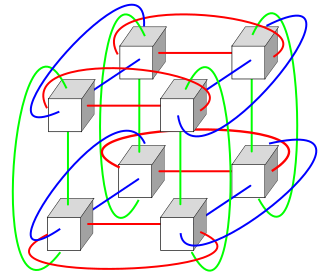In computer science, a priority queue is an abstract data-type similar to a regular queue or stack data structure in which each element additionally has a "priority" associated with it. In a priority queue, an element with high priority is served before an element with low priority. In some implementations, if two elements have the same priority, they are served according to the order in which they were enqueued; in other implementations ordering of elements with the same priority remains undefined.

Network topology is the arrangement of the elements of a communication network. Network topology can be used to define or describe the arrangement of various types of telecommunication networks, including command and control radio networks, industrial fieldbusses and computer networks.

Meiko Scientific Ltd. was a British supercomputer company based in Bristol, founded by members of the design team working on the Inmos transputer microprocessor.
In computer science, a binomial heap is a data structure that acts as a priority queue but also allows pairs of heaps to be merged. It is important as an implementation of the mergeable heap abstract data type, which is a priority queue supporting merge operation. It is implemented as a heap similar to a binary heap but using a special tree structure that is different from the complete binary trees used by binary heaps. Binomial heaps were invented in 1978 by Jean Vuillemin.

Quadrics was a supercomputer company formed in 1996 as a joint venture between Alenia Spazio and the technical team from Meiko Scientific. They produced hardware and software for clustering commodity computer systems into massively parallel systems. Their highpoint was in June 2003 when six out of the ten fastest supercomputers in the world were based on Quadrics' interconnect. They officially closed on June 29, 2009.
In computer science, a skip list is a probabilistic data structure that allows search complexity as well as insertion complexity within an ordered sequence of elements. Thus it can get the best features of a sorted array while maintaining a linked list-like structure that allows insertion, which is not possible in an array. Fast search is made possible by maintaining a linked hierarchy of subsequences, with each successive subsequence skipping over fewer elements than the previous one. Searching starts in the sparsest subsequence until two consecutive elements have been found, one smaller and one larger than or equal to the element searched for. Via the linked hierarchy, these two elements link to elements of the next sparsest subsequence, where searching is continued until finally we are searching in the full sequence. The elements that are skipped over may be chosen probabilistically or deterministically, with the former being more common.

The fat tree network is a universal network for provably efficient communication. It was invented by Charles E. Leiserson of the Massachusetts Institute of Technology in 1985.
Optical computing or photonic computing uses photons produced by lasers or diodes for computation. For decades, photons have shown promise to enable a higher bandwidth than the electrons used in conventional computers.
An optical link is a telecommunications link that consists of a single end-to-end optical circuit. A cable of optical fibers, possibly concatenated into a dark fiber link, is the simplest form of an optical link.
In computer networking, if the network is bisected into two partitions, the bisection bandwidth of a network topology is the bandwidth available between the two partitions. Bisection should be done in such a way that the bandwidth between two partitions is minimum. Bisection bandwidth gives the true bandwidth available in the entire system. Bisection bandwidth accounts for the bottleneck bandwidth of the entire network. Therefore bisection bandwidth represents bandwidth characteristics of the network better than any other metric.
In computer science, the prefix sum, cumulative sum, inclusive scan, or simply scan of a sequence of numbers x0, x1, x2, ... is a second sequence of numbers y0, y1, y2, ..., the sums of prefixes of the input sequence:
In distributed computing, leader election is the process of designating a single process as the organizer of some task distributed among several computers (nodes). Before the task has begun, all network nodes are either unaware which node will serve as the "leader" of the task, or unable to communicate with the current coordinator. After a leader election algorithm has been run, however, each node throughout the network recognizes a particular, unique node as the task leader.
Multistage interconnection networks (MINs) are a class of high-speed computer networks usually composed of processing elements (PEs) on one end of the network and memory elements (MEs) on the other end, connected by switching elements (SEs). The switching elements themselves are usually connected to each other in stages, hence the name.

Active cables are copper cables for data transmission that use an electronic circuit to boost the performance of the cable. Without an electronic circuit a cable is considered a 'passive' cable. Passive cables are liable to degrade the data they carry, due to "channel impairments" including attenuation, crosstalk and group velocity distortion. In active cables, a circuit using one or several integrated circuits is embedded in the cable to compensate for some or all of these impairments. This active boosting allows cables to be more compact, thinner, longer and transmit data faster than their passive equivalents.
Collective operations are building blocks for interaction patterns, that are often used in SPMD algorithms in the parallel programming context. Hence, there is an interest in efficient realizations of these operations.

A torus interconnect is a switch-less network topology for connecting processing nodes in a parallel computer system.

A butterfly network is a technique to link multiple computers into a high-speed network. This form of multistage interconnection network topology can be used to connect different nodes in a multiprocessor system. The interconnect network for a shared memory multiprocessor system must have low latency and high bandwidth unlike other network systems, like local area networks (LANs) or internet for three reasons:
The two-tree broadcast is an algorithm that implements a broadcast communication pattern on a distributed system using message passing. A broadcast is a commonly used collective operation that sends data from one processor to all other processors. The two-tree broadcast communicates concurrently over two binary trees that span all processors. This achieves full usage of the bandwidth in the full-duplex communication model while having a startup latency logarithmic in the number of partaking processors. The algorithm can also be adapted to perform a reduction or prefix sum.
Broadcast is a collective communication primitive in parallel programming to distribute programming instructions or data to nodes in a cluster it is the reverse operation of reduce. The broadcast operation is widely used in parallel algorithms, such as matrix-vector multiplication, Gaussian elimination and shortest paths.

In graph theory, the shuffle-exchange network is an undirected cubic multigraph, whose vertices represent binary sequences of a given length and whose edges represent two operations on these sequence, circular shifts and flipping the lowest-order bit.










